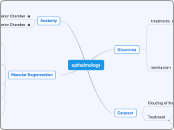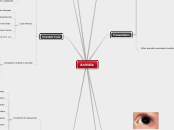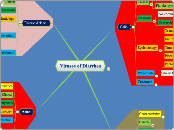opthalmology
Macular Degeneration
possible to slow down the "wet" form
two forms
wet
abnormal vascularization
dry
atrophy and scarring
common
affects center of the visual field
Damage to retina
mitochondrial dysfunction may play a role
Oxidative stress
loss of photoreceptors
Age Related Macular Degeneration
Anatomy
Anterior Chamber
Posterior Chamber
Cataract
Treatment
AGE bodies stick to lens?
Surgery
endophthalmitis
retinal detachment
Intracapsular Cataract Extraction (ICCE)
complications
Manual Small Incision Cataract Surgery
popular in developing countries w/out access to phacoemulsification
incision very large
remove the lens through a scleral tunnel wound
Extracapsular Cataract Extraction (ECCE)
when emulsification is problematic
remove the lens manually, leave capsule intact
Phacoemulsification
a plastic lens is inserted instead
use ultrasound to to emulsify or turn the lens into liquid, and then suck it away
Capsulorhexis
circular hole in the capsule where lens sits
to replace cloudy lens
Clouding of the lens
Glaucoma
mechanism
All types of optic neuropathy
visual field reduced
vision loss irreversible
Ciliary processes
Aqueous humor
drained by trabecular meshwork
most people, with treatment, will not lose their sight
IOP
Optic nerve cannot tolerate high pressure
above 2.8 kPa
loss of retinal ganglion cells
Intraocular Pressure
ocular hypertension
treatments
alternatives
Canaloplasty
ocular version of angioplasty
extremely fine catheter to clear the drainage canal
improve aqueous circulation through the trabecular outflow
Trabectome
reduce resistance to outflow of aqueous humor
uses heat to warm up the trabecular meshwork
a probe
in anterior chamber through the cornea
ExPress mini glaucoma shunt
in anterior chamber, under the scleral flap
stainless steel device
surgery
Nonpenetrating
not as effective at trabeculoctomy
requires greater surgical acumen
doesn't enter anterior chamber
newer
Drainage implant
preferred in some cases
scar tissue, etc.
less efficient than trabeculoctomy
a silicone tube extends into the anterior chamber
Trabeculectomy
flap allows fluid to escape
passage in the sclera
white of eye
open & closed angle
when laser/pills don't work
laser surgery
Cycloablation
Endoscopic Cyclophotocoagulation (ECP)
instrument is placed inside the eye to apply energy directly to the ciliary body tissue
Transscleral cyclophotocoagulation
go through the outer sclera
for elevated IOP after other treatments failed
reduce aqueous humor by destroying part of ciliary body, which produces the fluid
open-angle glaucoma
Laser Peripheral Iridotomy (LPI)
Helps with pupillary blockage
Make an opening through the iris
lets aqueous fluid flow from behind the iris to the anterior chamber of the eye
for angle-closure glaucoma
Trabeculoplasty
types
Selective Laser Trabeculoplasty (SLT)
May be done multiple times
leaves much of the meshwork intact
Uses very low levels of energy
Argon Laser Trabeculoplasty (ALT)
increase drainage flow
ALT is successful with 75% of patients
half of the meshwork is treated first
treat trabecular meshwork of the eye
for open-angle glaucoma
focus on the drain so that aqueous fluid can pass easily out of the drain
results in a few weeks
takes 10-15 minutes
most common
for open angle glaucoma
medication
Carbonic anhydrase inhibitors
Miotics
Pilocarpine
Adrenergic agents
Beta blockers
side effects
Prostaglandin analogs
Travoprost (Travatan)
Bimatoprost (Lumigan)
Latanoprost (Xalatan)
pills
eye drops









